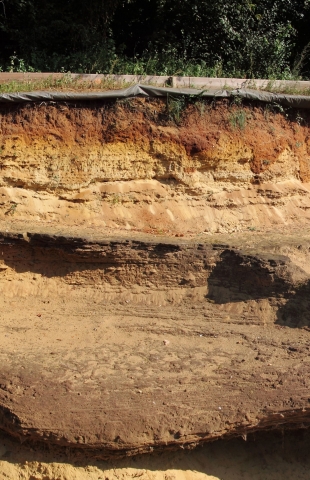Doppert, J.W.Chr., Ruegg, G.H.J., Van Staalduinen, C.J., Zagwijn, W.H., Zandstra, J.G. 1975. Formaties van het Kwartair en Boven-Tertiair in Nederland. In: Zagwijn, W.H., Van Staalduinen, C.J. (eds.): Toelichting bij geologische overzichtskaarten van Nederland. Rijks Geologische Dienst, Haarlem, 11-56.
Ebbing, J.H.J., De Lang, F.D. 2003. Beschrijving lithostratigrafische eenheid. Nederlands Instituut voor Toegepaste Geowetenschappen TNO. Utrecht.
Gibbard, P.L., Zalasiewicz, J.A., Mathers, S.J. 1998. Stratigraphy of the marine Plio-Pleistocene crag deposits of East Anglia. Mededelingen Nederlands Instituut voor Toegepaste Geowetenschappen TNO, 60, 239-262.
Hodgson, G.E. 1989. Microfacies of the Late Cenozoic southern North Sea. PhD Thesis, University of East Anglia, 431 p.
Long, D., Laban, C., Streif, H., Cameron, T.D.J., Schüttenhelm, R.T.E. 1988. The sedimentary record of climatic variation in the southern North Sea. Philosophical Transactions of the Royal Society London B, 318 (1191), 523-537.
Mathers, S.J., Zalasiewicz, J.A. 1988. The Red Crag and Norwich Crag formations of southern East Anglia. Proceedings of the Geologists' Association, 99, 261-278.
Rijsdijk, K.F., Passchier, S., Weerts, H.J.T., Laban, C., Van Leeuwen, R.J.W., Ebbing, J.H.J. 2005. Revised Upper Cenozoic stratigraphy of the Dutch sector of the North Sea Basin: towards an integrated lithostratigraphic, seismostratigraphic and allostratigraphic approach. Netherlands Journal of Geosciences 84, 129-146. https://doi.org/10.1017/S0016774600023015
Van den Berg, M.W., Gaemers, P. 1993. Tertiair. In: Van den Berg, M.W., Den Otter, C. (eds.): Toelichtingen bij de Geologische kaart van Nederland 1:50.000. Blad Almelo Oost/Denekamp (28O/29). Rijks Geologische Dienst, Haarlem.
Vernes, R.W., Deckers, J., Bakker, M.A.J., Bogemans, F., De Ceukelaire, M., Doornenbal, J.C., den Dulk, M., Dusar, M., Van Haren, T.F.M., Heyvaert, V.M.A., Kiden, P., Kruisselbrink, A.F., Lanckacker, T., Menkovic, A., Meyvis, B., Munsterman, D.K., Reindersma, R., ten Veen, J.H., van de Ven, T.J.M., Walstra, J., Witmans, N. 2018. Geologisch en hydrogeologisch 3D model van het Cenozoïcum van de Belgisch-Nederlandse grensstreek van Midden-Brabant / De Kempen (H3O – De Kempen). Studie uitgevoerd door VITO, TNO-Geologische Dienst Nederland en de Belgische Geologische Dienst in opdracht van Vlaams Planbureau voor Omgeving, Vlaamse Milieumaatschappij, TNO, Geologische Dienst Nederland, Nederlandse Provincie Noord-Brabant, Brabant Water, Programmabureau KRW/DHZ Maasregio.
